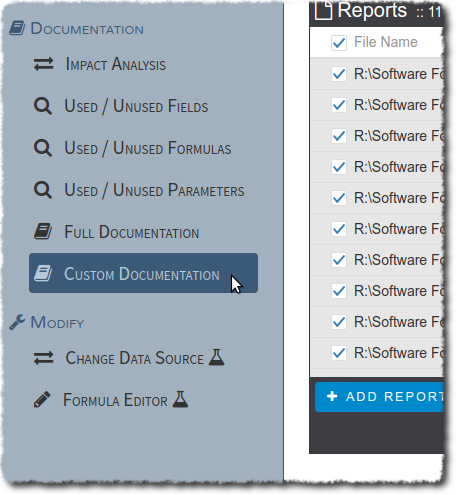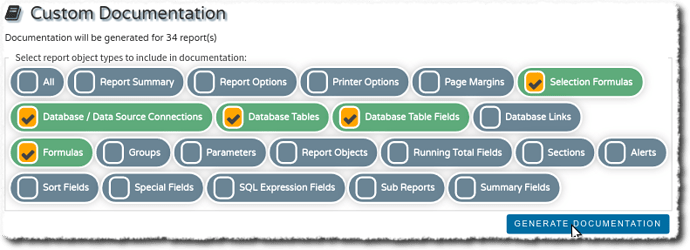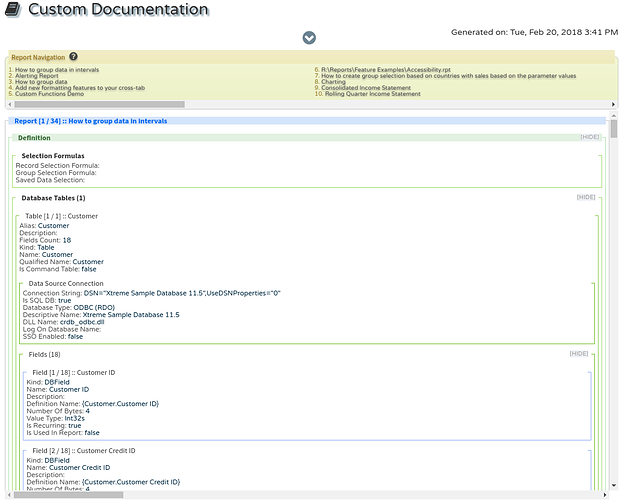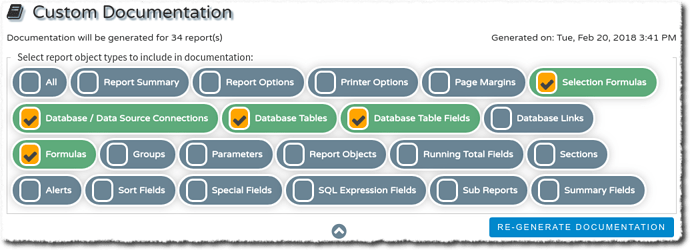Every Crystal Report you have consists of objects (i.e. database, formulas, parameters, running totals, SQL expressions, etc.) and information about those objects we call properties.
Wouldn’t it be great if you could get a very detailed document / report of what’s inside of your reports, focused on specific object(s) of interest?
Wouldn’t it be even better if you could know which of those objects are actually used in the design of your reports and which are not?
Wouldn’t it be amazing if you could get this kind of document / report for multiple reports at the same time?
This can be quickly and easily done using the .rpt Inspector Online Custom Documentation tool (also available, the Full Documentation tool how to guide for all your objects).
-
In the main reports grid, select report(s) for which you wish to perform this on.
-
Click on the Custom Documentation tool in the Documentation area of the left side navigation

-
Once the Custom Documentation tool page opens, it will show you a list of object types you can select to include in the documentation. After you’ve selected the specific object type(s), click on the
Generate Documentationbutton.Note: Selecting
Allis equivalent to using the Full Documentation tool
-
.rpt Inspector Online will show you a spinner while it processes the request. Once completed, you will see a report of the selected objects and properties for the reports you selected in step 2. For each report, the objects and properties are grouped in to multiple sections so it’s easier to find and navigate. The groupings are (depending on the object type(s) you selected in step 3 some of these will not be shown):
-
Summary - this grouping contains general information about the report such as the title, filename, version, kind, whether it has saved data, and whether it’s a sub report. This grouping also contains a counts of additional object types that are used within the definition of the report. The counts are links which can be clicked on which will navigate directly to that object’s properties.
-
Report Options - this grouping contains options that were enabled / disabled for the report. These are set in Crystal Reports by going in to the File menu, selecting Report Options, and going to the Reporting tab.
-
Printer Options - this grouping contains options that were set for the page and printer when the report was saved. These are set in Crystal Reports by going in to the File menu, selecting Page options.
-
Page Margins - this grouping contains options that were set for the page margins when the report was saved. These are set in Crystal Reports by going in to the File menu, selecting Page options.
-
Definition - this grouping contains all the objects and their properties are associated to the report. These include
Alerts,Areas(and their sections),Data Source Connections,Database Tables,Database Table Links,Formulas,Groups,Parameters,Running Totals,Sections,Sort Fields,Special Fields,SQL Expressions, andSummary Fields
The screen shot below is an example of what you’ll see:
-
-
At the top, you’ll notice a Report Navigation section. Clicking on one of the reports in the navigation will move directly to that report’s objects and properties information.

-
If you included the
Report Summaryobject type in your selection, then you’ll also notice that in theSummarygrouping for each report documented is aCounts by Object Types in Report. Each of the count object type titles is a link/admin#/users/list (hover over the title and you’ll see it will show an underline, signifying that it’s a link) you can click which will take you directly to that object type for that report.

-
We give you a lot of information for each object. Depending on the design of your reports, some objects will contain only contain one item of an object type (i.e. 1 table instead of 7 tables) while others will contain multiple. In addition to the two helpful navigation aides already mentioned, each object type can be toggled to hide / show.
Example of shown details which you can click to Hide:

Example of hidden details which you can click to Side:

-
Though not shown in the
Counts by Object Types in Report(as noted in #6, this is only shown in theSummarygrouping if you included theReport Summaryobject type in your selection), for eachTablewe also show you details about theFields(ifDatabase Table Fieldsobject type is also selected) in each table:
-
Where applicable, we’ll show you whether the object is used in the design of the report

-
Where applicable, we’ll show you whether the object is recurring

-
To find / search for specific text (i.e. a parameter name, or a formula definition or part of it), simply use the browser’s built in search by pressing
CTRLF
The browser will prompt you to provide the text to search / find:

And will show you the number of matches found as well as allow you to navigate to each match in the search / find entry. The matches will be highlighted in the body:

-
Click on the
Chevron(an icon that points down) at the top as indicated in the image below. It will reveal the object types selection so that you can select / unselect object types and re-generate the documentation.

Here’s what it looks like when theChevronhas been clicked. Should you change your mind, click on theChevronagain (when it’s pointing to the top) it will hide the object types selection.
Screen shots of some of the additional objects and their properties can be seen in the Full Documentation how to.



